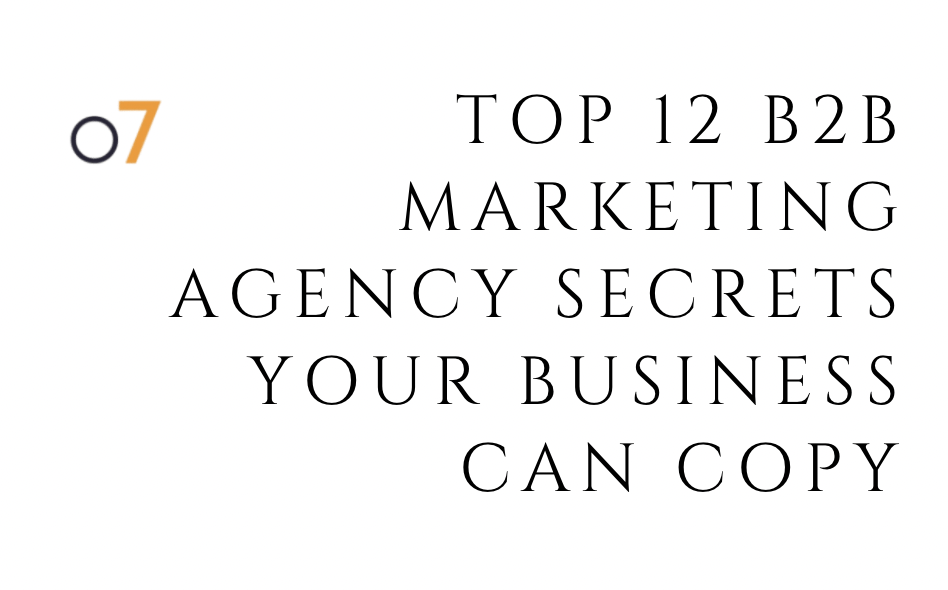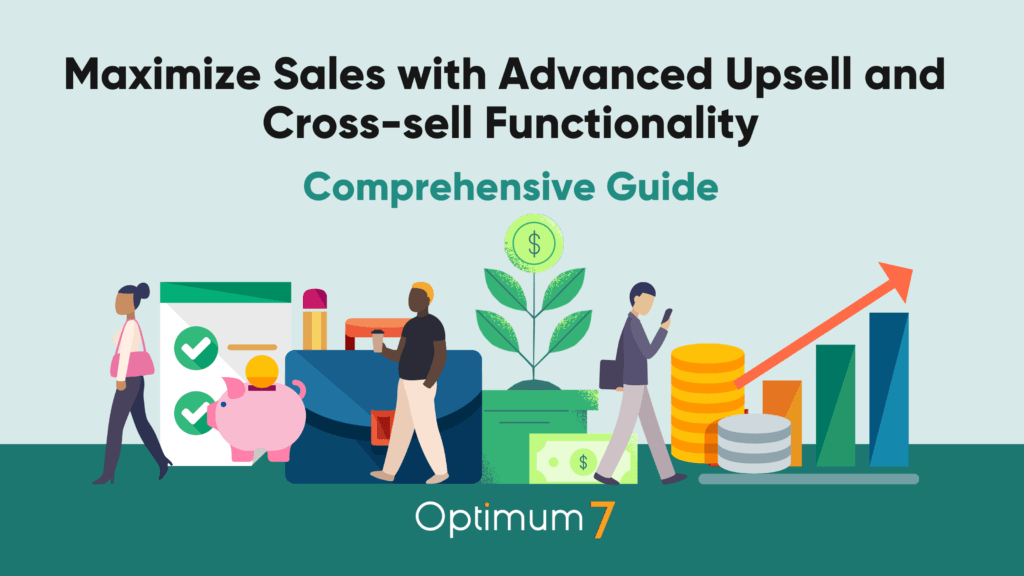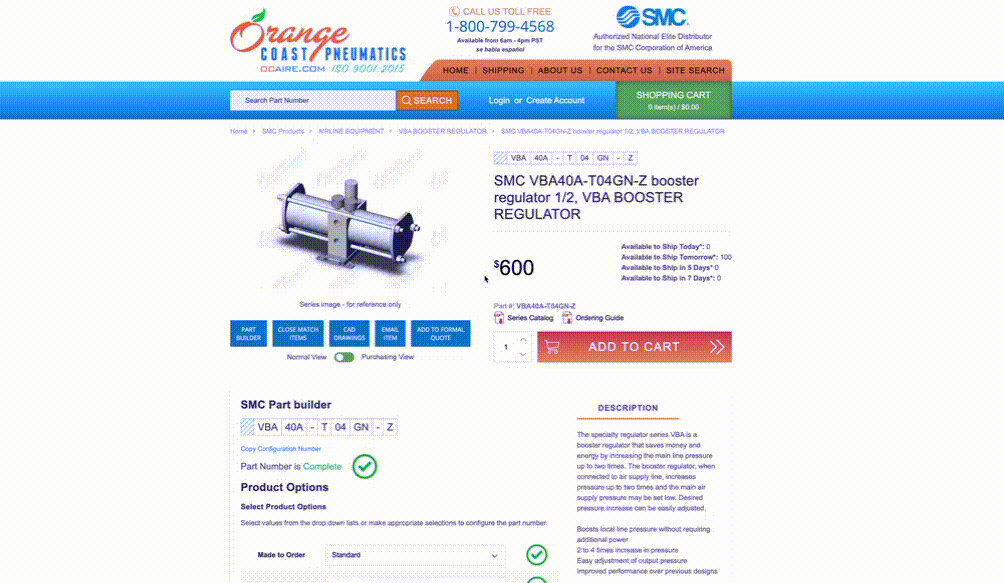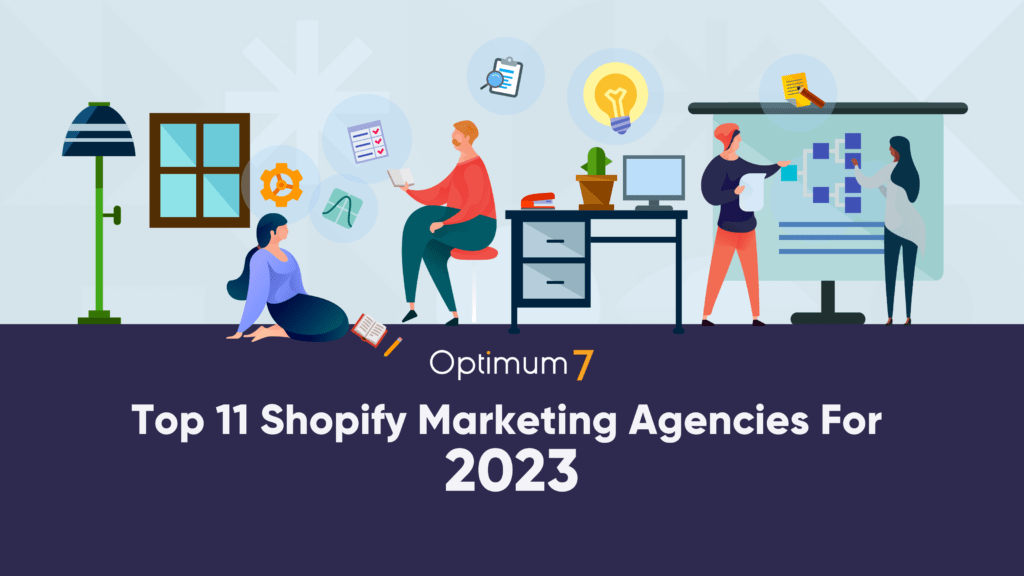B2B marketing strategies can make or break the success of your company. Many marketers in this space rely on generic marketing campaigns that don’t reach highly specific prospects or move the needle.
Regardless of the product or service your business offers, a cookie-cutter marketing plan just won’t get the job done in the B2B space. This segment is over-saturated and highly competitive.
Don’t believe me? A recent study found that just 41% of B2B organizations handle marketing activities in-house. That means that roughly 60% of B2Bs are getting assistance from external sources.
Your competitors are out there trying to secure the best B2B marketing agency. These B2B digital marketing agencies eat, sleep, and breathe B2B marketing 24/7/365.
But even if you’re not ready to hire a top B2B marketing agency just yet, you can still use this guide as a blueprint for your B2B marketing strategy.
I’ll share some of my favorite secrets used by B2B marketing experts. Feel free to copy these and use them for your business.
1. Focus On a Longer Buying Cycle
This is something that beginners commonly overlook in the B2B marketing space. They run an ad or launch a new campaign and get disappointed when new leads aren’t coming in the next day. So they get discouraged, assume there’s a problem with the campaign, and go back to the drawing board.
But if your campaigns aren’t nurturing prospects through a long buying cycle, running a new ad won’t make any difference.
You need to understand that there are significant differences between general consumers and business prospects. B2Bs typically make a larger investment when it comes to buying goods or services. So leads move through B2B marketing funnels at a much slower pace.
A recent study from Gartner found that 77% of B2B buyers said their most recent purchase was complex or very difficult. That’s because so many factors weigh on the decision.
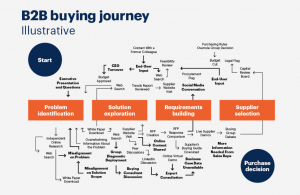
As a marketer, you need to understand this concept and do whatever you can to simplify decisions for your prospects. Look for ways to market your brand in a way that solves business strategy problems for your target market.
Providing highly informative marketing materials will make a big difference here.
For example, a potential client may want to download an ebook and attend one of your webinars before they even consider your product or service. From there, they may even want to conduct a comprehensive ROI analysis to ensure the purchase is a smart business decision. It could take weeks or even months for this prospect to move through your funnel.
As a top B2B marketing agency, we understand this concept and help our clients adjust their strategy accordingly to be more informative. This ultimately caters to a longer buying cycle.
2. Create an SEO Keyword Universe and Hierarchy
Search engine optimization (SEO) for marketing purposes is far from a secret. But you need to take your basic SEO strategy to the next level with a keyword universe and hierarchy.
A keyword universe shows all of the words and phrases driving organic traffic to your website. This can include terms you’re already ranking for, as well as terms you hope to rank for.
Google Search Console can be a powerful tool for this strategy. That’s because you can easily see what keywords are driving the most organic traffic to your site over any period of time. You can even see which keywords are driving traffic to specific pages on your site.
Sometimes this data is surprising. You may quickly discover that some of your blog posts are driving significantly more traffic to your site than you expected.
For example, let’s say you’re offering B2B services in the credit card processing space. You’d likely be trying to rank for terms like “credit card processors” or “lowest credit card processing rates.” But Google Search Console might tell you that a blog post related to manually keyed credit card transactions drives the most organic traffic to your site.
Once you’ve created your keyword universe, you’ll need to create a hierarchy of these terms based on priority. Factors like search volume, competition level, and existing traffic should all be taken into consideration here.
Then you can take your top keywords and create variations of them, especially variations that include questions.
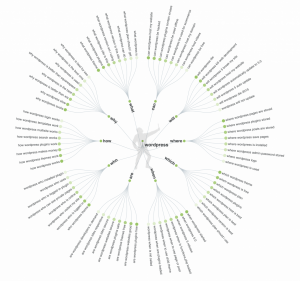
This forces you to think about how people are searching for terms related to your offering. Then you can ultimately use this information to enhance your SEO strategy.
3. Leverage LinkedIn Touch Points
LinkedIn is more than just a networking platform. In fact, it’s the most popular social media marketing channel for B2B marketers.
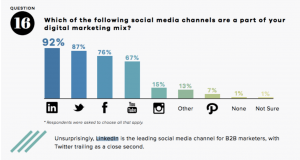
More than 90% of B2B marketers use LinkedIn in one way or another in their marketing strategy. So what’s the big secret?
Beyond the obvious LinkedIn marketing strategies like LinkedIn ads, posts, and Pulse articles, there are other steps you can take to gain a true edge over your competitors.
On Linkedin, quality is so much more important than quantity. So you should be taking advantage of the following touchpoints in your outbound B2B marketing efforts:
- Connections — Identify your ideal customer profile and try to connect anywhere from 50 to 100 of those people per day.
- Engaging on Prospects Posts — After you make these connections, see which of your top prospects have recently posted on LinkedIn. Make an effort to engage with their content often. Just don’t go overboard and comment on every single post. This comes off as too spammy.
- Engagement on Your Posts — Make an effort to publish posts on your own profile. When people engage with your content, make sure you like and comment back to keep the conversation going.
- Direct Messages — After you’ve engaged with a prospect and they’ve engaged back, you can take the next step in a direct message. Don’t pitch them just yet. Simply continue the conversation from a comment or send them a blog that’s relevant to their role, company, or something they’ve recently posted.
- Follow-Ups — Eventually, you can follow up with this person about your direct message and use that as a transition to your pitch.
These touchpoints are much more personal than just running generic targeted ads. So you’ll likely see better results, and higher quality leads with this strategy.
4. Spy On Your Competition
You need to recognize the fact that your marketing efforts don’t exist in a vacuum. There are tons of external factors that contribute to your success, and your competitors play a significant role here.
Whether you’re using SEO, PPC, or a combination of the two, it’s crucial that you understand who you’re fighting against for these keywords.
Spying on your competition can help you identify the low-hanging fruit and identify the biggest opportunities for your campaigns. Not only will this generate more leads for your company, but it will also save you a ton of money.
So how exactly do you spy on your competitors? Tools like SpyFu will make your life much easier.
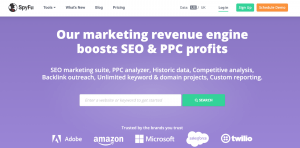
Beyond SEO, PPC, and keyword research, SpyFu will also help you identify the backlink strategies for your competitors as well.
When you have this type of information at your disposal, it gives you a significant advantage as a B2B marketer. Now you have the opportunity to mirror what your competitors are doing well, avoid what they’re doing poorly, and identify gaps in their marketing strategy. Then you can focus your campaigns around filling those gaps.
5. Setup Your CRM to Track Incoming Lead Quality
Using CRM software to manage leads definitely isn’t a secret. But if your leads aren’t segmented or sorted by quality, it’s putting you at a massive disadvantage.
As I’m sure you know, all leads are not created equally. The way they move through B2B marketing funnels varies by their source, needs, and behavior.
If you customize your CRM to track lead quality, it’s much easier for you to identify exactly where that person is within your funnel. Then you can continue to provide them with appropriate marketing materials and campaigns based on their status.
Here’s a basic example of a lead scoring model to showcase my point:
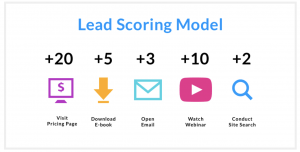
Leads that open an email or conduct a search on your site aren’t the same quality as a lead who downloaded an ebook or watched a webinar.
If someone takes the time to sit through one of your webinars, then they’re genuinely interested in your product or service. Now they’re just educating themselves more on if this solution is right for their needs.
By the time someone gets to your pricing page, they’re in the consideration phase of the buying cycle. The way you market your brand to this lead should be different from your marketing strategy to target someone who opens your marketing emails.
6. Leverage Video With Emotion
Video marketing in the B2B space tends to get lots of resistance. Here are some of the top challenges related to video marketing, according to B2B marketers:
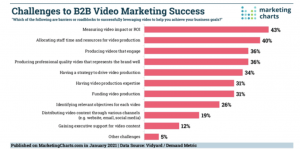
But you can’t let these obstacles blind you from the power of video marketing. Videos are arguably the fastest way to tell your story, engage with leads, and build brand awareness.
A recent study found that 89% of marketers found that video campaigns resulted in a high ROI. An additional 83% said that videos improved their lead generation strategy.
The effects of video marketing are even more powerful when you can trigger an emotional response from your audience. You need to identify your target audience’s potential fears and pain points, then find ways to leverage those emotions in a video.
For example, let’s say you own a law firm that specializes in employment law for mid-size businesses. You could create a video highlighting the dangers of an employee lawsuit and its damages to a business. The video could explain how these could easily be prevented by retaining a specialized law firm to review your employee handbook, hiring practices, and other crucial parts of your HR department.
In this example, fear is the emotion that you’re trying to reach. Employers will act quickly as a preventative measure if they’re afraid something could go wrong down the road.
7. Use an Email Automation for Nurture
Email marketing in the B2B space can be tricky. Lots of marketers use cold email outreach as a way to target high-quality prospects. But personalized outreach isn’t always realistic at scale.
With that said, you can’t treat contacts on your B2B email list the same way as everyday consumers. Sending them generic mass marketing emails won’t really move the needle.
The solution? You need to find a happy medium between these two extremes. The only way to accomplish this is by taking advantage of email automation to nurture your leads.
The top B2B marketing agencies understand that automation helps generate higher-quality leads.
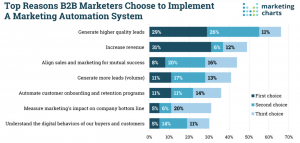
You need a solution that will let you create unique campaigns based on the behavior and actions of each contact.
For example, someone who opens an email and signs up for a webinar using a CTA in the message shouldn’t be placed in the same sequence as a contact who ignores your emails altogether. There needs to be a logical sequence based on their behavior.
8. Content Strategy Specific to Problems That You Solve
Businesses don’t buy products or services—they buy solutions. The sooner you understand this concept, the easier it will be for you to create a B2B content strategy.
Avoid examples, use cases, or promotional materials that are focused on your product. Instead, focus on the solution.
What exactly does your brand do for businesses? Examples might include:
- Improve internal business communications
- Enhance employee engagement
- Reduce user acquisition costs
- Build customer loyalty
- Improve support ticket response times
- Simplify employee onboarding
Let’s say your company sells app development services to eCommerce companies. You’re not selling a mobile app—you’re solving problems related to mobile conversion rates.
If you’re not ready to consult with a B2B digital marketing agency, then turn to your staff and engineers on your team for help with this content.
9. Invest in Technology by Building Your Own Systems
This is something that will truly separate you from the competition. Rather than using an existing CRM or CMS, you can build your own systems.
Don’t get me wrong; there are plenty of great CRM and CMS platforms on the market. But even the best options will still be somewhat limited in terms of custom functionality. At the end of the day, these are cookie-cutter solutions and won’t accommodate the specific needs of your B2B marketing strategy.
This type of custom software development may not be necessary for B2C companies. But due to the highly specific needs of B2B marketers, investing in this type of technology will set you up for long-term success.
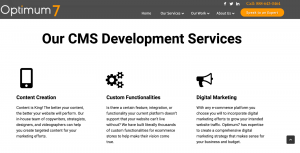
Most businesses don’t have the tools or internal resources to do this alone. So look for the best B2B marketing agency to help you with this process.
Whether you want something completely unique or just need help customizing your existing technology, our team of development experts here at Optimum7 can help provide assistance.
10. Create a Social Media Presence and Sharing Schedule
Social media is another tricky aspect of B2B marketing strategies. That’s because business users aren’t using social channels the same way as general consumers. So you’re likely wasting your time and money if you’re using Instagram stories in an attempt to reach prospects.
But you still need an active presence on social media. If someone looks up your company and sees you haven’t posted on Facebook, LinkedIn, or Twitter in months, they may question whether or not you’re still in business.
Plus, posting on social media helps create brand awareness and keeps your company top-of-mind for prospects.
If you don’t want to allocate time every day to post on social channels, you can use tools like Agorapulse to automate postings for you.

This is one of my favorite ways to create a social sharing schedule. Plus, you can use it as a team collaboration tool for your big-picture social strategy.
You can schedule a new blog post to be shared on Facebook one day and then automatically share that same post on LinkedIn later in that week.
11. Always Get Client Testimonials and Videos
Client testimonials are extremely powerful. If someone is willing to put their name, face, and the company behind your product, it tells prospects that your product and services are legitimate.
Here’s an example of some testimonials I found on SpyFu’s homepage:
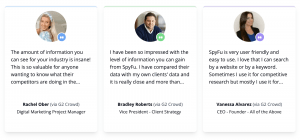
A whopping 72% of people say that positive testimonials increase their trust in a business. This is even more significant in the B2B space. 97% of B2B buyers said testimonials are the most reliable type of content.
That’s because business buyers view testimonials the same way as peer recommendations.
They see that the VP or CMO of a reputable company is using and recommending the product. That person wouldn’t put their reputation on the line to pitch a product or service that didn’t actually work for their brand.
Written testimonials like the examples above are great. But if you can get a video testimonial, it takes your marketing strategy to a whole new level.
We already discussed the importance of video marketing earlier. Now pair that with the concept that someone took the time out of their day to participate in a video testimonial. This client must REALLY like your product or service—that’s going to be a key takeaway from prospects watching the video.
12. Always Create Case Studies
If you reach out to any B2B online marketing agency, they’ll all tell you the same thing—there’s no such thing as having too many case studies.
This is especially important in the B2B marketing space. That’s because your prospects here are so results-driven. Case studies are the easiest way to show proof of concept with real numbers and examples.
Studies show that case studies are the most trusted form of marketing content.
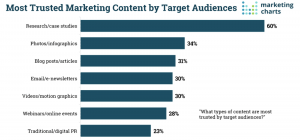
Why?
If you think about it, case studies are one of the only things a marketer can’t fake. Your product pages, landing pages, blogs, email newsletters, webinars, ads, and everything else will obviously paint a good picture of the brand. Buyers know this, so they take what you say with a grain of salt.
But with a case study, you’ll be using results from your clients to show how you solved their problems.
It’s one thing to say, “our brand helps businesses improve employee training for enterprises.” But it’s more powerful to show a case study explaining how you helped a specific company save $650,000 on employee training costs across 15 locations in 12 months.
That’s the power of a case study.
Final Thoughts
These top B2B marketing agency secrets can take your business to new heights.
They aren’t basic or generic strategies that you’ll find just anywhere. The tips in this guide come straight from B2B marketing trends and real campaigns that we’ve used here at Optimum7.
If you’re having trouble applying these concepts on your own, or need help with something a bit more advanced, don’t hesitate to reach out and speak to an expert on our team.

